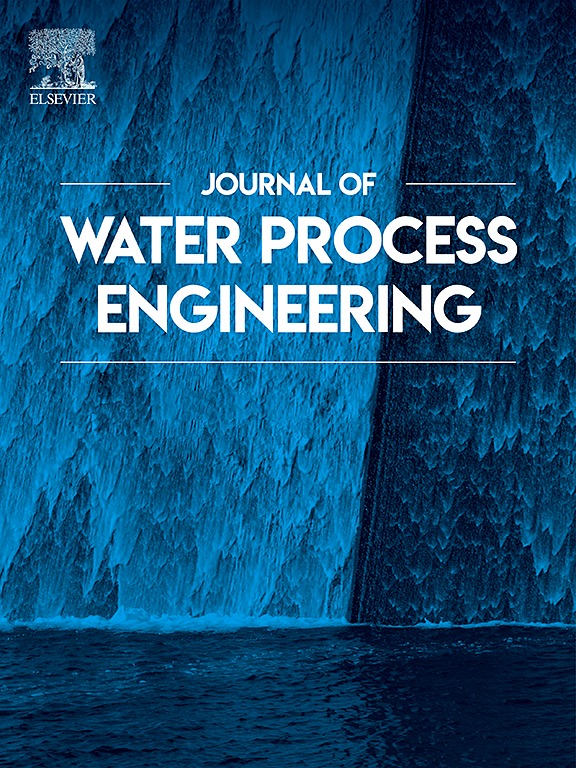聚乙烯亚胺功能化磁性硅纳米复合材料的制备及其对六价钼离子的快速去除和回收
IF 6.3
2区 工程技术
Q1 ENGINEERING, CHEMICAL
引用次数: 0
摘要
钼是一种昂贵的稀有金属,有着广泛的应用,但各种工业排放的含Mo(VI)离子的废水对人类健康和生态系统构成潜在危害。因此,需要开发合适的方法从工业废水中分离和回收钼。在本工作中,通过简单的方法(60°C, 1 h)合成了聚乙烯亚胺(PEI)功能化磁性硅(PEI@SiO2@Fe3O4)纳米复合材料,并首次将其作为吸附剂用于Mo(VI)离子的高效去除和回收。利用傅里叶变换红外光谱仪、扫描电镜等对制备的PEI@SiO2@Fe3O4纳米复合材料进行了表征。吸附性能研究表明,PEI@SiO2@Fe3O4在298 K下的吸附量高达409.8 mg/g,吸附动力学快速,吸附平衡时间为45 min,吸附过程是自发的、吸热的,符合Langmuir等温线和拟二级动力学模型。可能的吸附机制包括配位键和静电相互作用。使用Na3PO4溶液(20 g/L),仅需2分钟即可将吸附的Mo(VI)离子从PEI@SiO2@Fe3O4吸附剂上完全洗脱。经过7次吸附-解吸循环后,PEI@SiO2@Fe3O4具有出色的可重复使用性,吸附容量仅损失7%。然后将PEI@SiO2@Fe3O4应用于实际含Mo(VI)废水的处理,取得了非常满意的效果。这些结果表明PEI@SiO2@Fe3O4纳米复合材料是一种潜在的去除和回收废水中Mo(VI)的吸附剂。本文章由计算机程序翻译,如有差异,请以英文原文为准。

Facile synthesis of polyethyleneimine functionalized magnetic silicon nanocomposite for enhanced and rapid removal and recovery of hexavalent molybdenum ions
Molybdenum is an expensive rare metal with many application, however discharged effluents containing Mo(VI) ions from various industries constitute potential hazards to human health and the ecosystem. Thus, it is demanded to develop appropriate methods to separate and recover molybdenum from industrial wastewater. In the present work, polyethyleneimine (PEI) functionalized magnetic silicon (PEI@SiO2@Fe3O4) nanocomposite was synthesized by a facile approach (60 °C, 1 h), and then for the first time used as the sorbent for efficient removal and recovery of Mo(VI) ions. The prepared PEI@SiO2@Fe3O4 nanocomposite was then characterized using Fourier transform-infrared spectrometer, scanning electron microscoper, etc. Investigations of adsorption performances of the PEI@SiO2@Fe3O4 demonstrated its high adsorption capacity of 409.8 mg/g at 298 K and fast adsorption kinetics with an equilibrium time of 45 min, while the sorption process was spontaneous, endothermic and well fitted by Langmuir isotherm and the pseudo-second order kinetic model. The possible adsorption mechanisms include coordinate bonds and electrostatic interaction. The sorbed Mo(VI) ions were completely eluated off from PEI@SiO2@Fe3O4 sorbent using a Na3PO4 solution (20 g/L) within only 2 min. Outstanding reusability of PEI@SiO2@Fe3O4 was illustrated after seven adsorption–desorption cycles with only 7 % loss in sorption capacity. The PEI@SiO2@Fe3O4 was then applied to the treatment of real wastewaters containing Mo(VI), and very satisfactory results were achieved. These results suggest that the PEI@SiO2@Fe3O4 nanocomposite is a potential sorbent for removing and recovery of Mo(VI) from wastewater.
求助全文
通过发布文献求助,成功后即可免费获取论文全文。
去求助
来源期刊

Journal of water process engineering
Biochemistry, Genetics and Molecular Biology-Biotechnology
CiteScore
10.70
自引率
8.60%
发文量
846
审稿时长
24 days
期刊介绍:
The Journal of Water Process Engineering aims to publish refereed, high-quality research papers with significant novelty and impact in all areas of the engineering of water and wastewater processing . Papers on advanced and novel treatment processes and technologies are particularly welcome. The Journal considers papers in areas such as nanotechnology and biotechnology applications in water, novel oxidation and separation processes, membrane processes (except those for desalination) , catalytic processes for the removal of water contaminants, sustainable processes, water reuse and recycling, water use and wastewater minimization, integrated/hybrid technology, process modeling of water treatment and novel treatment processes. Submissions on the subject of adsorbents, including standard measurements of adsorption kinetics and equilibrium will only be considered if there is a genuine case for novelty and contribution, for example highly novel, sustainable adsorbents and their use: papers on activated carbon-type materials derived from natural matter, or surfactant-modified clays and related minerals, would not fulfil this criterion. The Journal particularly welcomes contributions involving environmentally, economically and socially sustainable technology for water treatment, including those which are energy-efficient, with minimal or no chemical consumption, and capable of water recycling and reuse that minimizes the direct disposal of wastewater to the aquatic environment. Papers that describe novel ideas for solving issues related to water quality and availability are also welcome, as are those that show the transfer of techniques from other disciplines. The Journal will consider papers dealing with processes for various water matrices including drinking water (except desalination), domestic, urban and industrial wastewaters, in addition to their residues. It is expected that the journal will be of particular relevance to chemical and process engineers working in the field. The Journal welcomes Full Text papers, Short Communications, State-of-the-Art Reviews and Letters to Editors and Case Studies
 求助内容:
求助内容: 应助结果提醒方式:
应助结果提醒方式:


